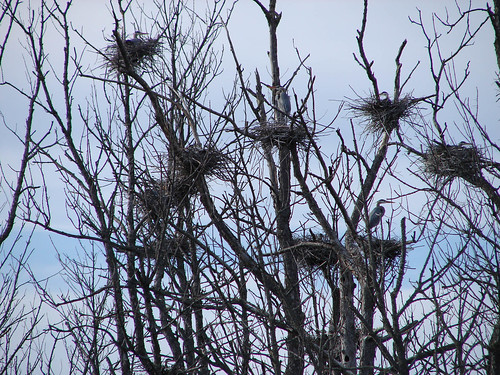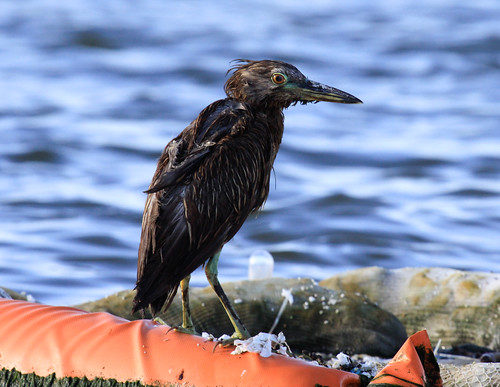Last time, I quoted Mark Roser telling me about his hand-feeding experiences with a Tufted Titmouse. The purpose of Mark’s email was actually something quite different, though. He had traveled down to the Gulf after the BP oil spill and saw some of its effects first-hand while he was working on a project developing sustainable means of restoring oiled marshes. Mark wrote, “There is a call for ideas for new bird research and restoration projects - and I thought you or your listeners might have some thoughts on potential new topics,” and he sent me a link for the website of the Deepwater Horizon Natural Resources Damage Assessment Trustees in which they ask people to submit bird and sturgeon restoration project ideas for their Open Ocean Restoration Area.
They target restoration for wide-ranging and migratory species at important points during their life cycles and geographic ranges, including inland, coastal, and offshore areas, and anticipate that some restoration may take place outside of the Gulf of Mexico. For example, many of the loons we enjoy every year in Minnesota, Michigan, and Wisconsin spend their winters down in the Gulf. Young loons remain there year-round, or work their way along the Atlantic coast, until they are at least 3 or 4 years old. Northern Gannets also winter in the Gulf as well as along the coast, and young gannets also remain in the Gulf for a few years before reaching adulthood and heading to their breeding colonies in the North Atlantic.
In this 2021 funding cycle, they’re prioritizing bird projects focused on restoring and conserving nesting and foraging habitat, establishing or re-establishing breeding colonies, and preventing incidental bird mortality. If you want more information, check here.
 |
| This is not the heron rookery near Rochester. I took this photograph in 2006 in St. Louis County. |
I also recently heard from Lynn Cornell, who wrote about a wonderful Great Blue Heron nesting colony in Rochester, Minnesota. The rookery is the most significant spot for heron nesting in Olmsted County and likely one of the more significant spots in Southeast Minnesota, and it’s ecologically significant as a rare upland rookery—most are in swamps.
The private land this rookery is on has long been zoned as “resource protected/potential suburban,” but the land owner, who happens to be a member of the county soil and water conservation board, requested on March 18 that 30 acres of his land be rezoned suburban. The Olmstead County Planning Advisory Commission approved the rezoning unanimously, and the very next day, property owners of adjoining land noticed stakes and survey markers in the woods, many of the stakes directly below heron nests. The process seemed excessively rushed to the neighbors—it hadn’t even been approved yet by Olmsted County, and one neighbor’s attorney filed an injunction to halt work, providing photos of dozens of heron nests in and around the grove of trees targeted for removal. When they found out the trees were scheduled to be removed the following Monday, the attorney brought a motion for a restraining order against development to District Court Judge Pamela A.W. King, who signed the order. The order prohibits removing any tree within 1,000 feet of a heron nest temporarily, until all the proper permitting is in place.
Birders in Rochester are working hard to protect the rookery—the herons are on nests already. Developers tend to reassure people that birds can move somewhere else—they have wings, after all. But it’s late in the season for commencing nesting. Destroying nest trees now will destroy the capacity for the pairs in the trees and anywhere near them to reproduce at all this year. And as project after project gets approved removing more and more wildlife habitat, there are fewer and fewer somewhere elses to move.
As a Minnesota resident, I signed a petition in for an environmental assessment worksheet for the proposed development, and a statement declaring my concern regarding the environmental harm proposed by this development. The group working to protect these wonderful birds and this unique resource has a Facebook group page by which they are trying to get the word out.
 |
| Baby Walter photo (c) 2021 by Laura Erickson. NO reproduction, please. |
Right now I’m watching just how carefully my daughter and son-in-law select clothing, blankets, and toys baby Walter could put in his mouth. They want to be sure every element is safe. How can we humans, many of us parents, possibly justify the horrific amounts of toxic chemicals we’ve allowed companies and individuals to release into our environment over years, decades, centuries, to seep into our groundwater supplies and the freshwater and saltwater bodies of water from which we get so much fish, seafood, and other food, to say nothing of the air we breathe and the water we drink? And that only considers the simplest issues of human self-interest, not even touching on our dependence on other species much less the very right of those other species to exist.
I want my little grandson to be able to see wonderful birds in the Gulf of Mexico, and to enjoy seeing nesting herons in Minnesota. What are we prepared to do to ensure a lovely world for our grandchildren? The Gulf Restoration Project and the fight to protect a special heron rookery are important for all of us.
 | |
|

